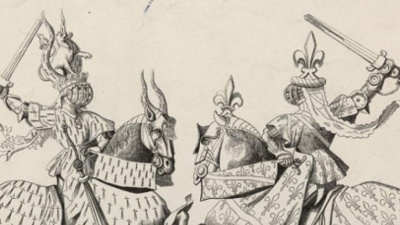
Jousts were, from the 13th to 16th century CE, a popular part of the European medieval tournament where knights showed off their martial skills by riding against one another with wooden lances in a designated area known as the lists. The two opposing knights, from c. 1400 CE, were separated by a barrier or tilt, hence the sport’s other name of tilting. Jousting was an important opportunity for heraldic display, general pageantry, and the chance for a knight to impress aristocratic ladies who might show them favour by giving them their scarf or veil. Jousting fell out of fashion by the end of the Middle Ages, but there were occasional revivals up to the 19th century CE.
Tournaments where knights fought in mock cavalry battles (mêlée), with the object of capturing as many of the opposing team as possible, probably began in France in the 11th century CE. By the following century, the trend had spread across Europe. Tournaments might last several days, very often in celebration of another event such as an important marriage or coronation. There were stalls with refreshments, sellers of horses and fine clothes, intermission performances of drama with musicians and acrobats, pageants, and several banquets over the course of the event.
Jousting became more common as an event of the tournament from the second half of the 13th century CE, although it had been a minor side event since the 11th century CE. The name joust perhaps originated from the Latin juxtare (‘to meet’), and the event was likely created in response to the greater emphasis on chivalry and honour in the later Middle Ages. It was much easier to display skills in an individual event in front of an audience as opposed to the free-for-all mêlée which took place across the countryside. A good knight was supposed to display such qualities as martial prowess (prouesse) and noble manners (debonnaireté), and those competitors with a criminal background or with a disreputable reputation were banned from competing (which is perhaps why some competed anonymously). As tournaments became ever-more spectacular social events of great pageantry, knights even had to prove their lineage to take part and displaying their family’s coat of arms on the shield, surcoat, and horse’s coat became the done thing.
Ladies attended jousts, sometimes they even sponsored the tournament itself, and they might give certain token articles, known as favours, to specific knights they favoured such as a veil which was then tied around the receiver’s lance. The ladies and other spectators watched from purpose-built stands, pavilions with balconies or simply tents.
Sometimes knights dressed up as such legendary figures as King Arthur, as traditional enemies like the Saracens, as monks, or even court ladies. This was especially so at the event known as the Round Table where knights each pretended to be a character from the Arthur legends. Another opportunity for jousting was during truces or sieges when knights from opposing armies jousted to pass the time, although the results could be lethal. Famous examples of these impromptu jousts occurred in Sicily in 1062 CE, Wurzburg (Germany) in 1127 CE, Rennes in 1357 CE and several times during the English-Scots wars of the 14th century CE.
Credit : World History Encyclopedia
Picture Credit : Google




